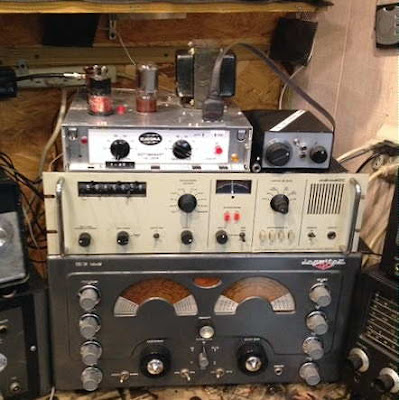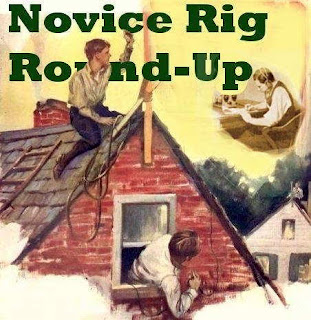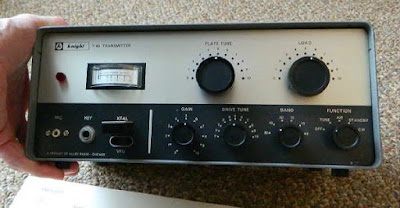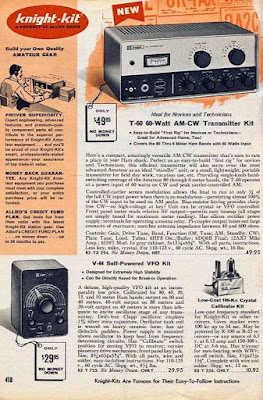 Here Comes The Novice Rig Roundup (NRR) 2020!
Here Comes The Novice Rig Roundup (NRR) 2020!
One of the most enjoyable operating events of the year is fast approaching -- the Novice Rig Roundup or 'NRR'. Technically, it is a contest, but I have the feeling that most participants think of it as just a lot of fun and a nice opportunity to hear and work some of the great old 'classics' of the past -- rigs that were used when they were teenage Novices or rigs that they could only drool about owning, back in those formative years when they each discovered the magic of radio.
Once again the bands will be alive with the sounds of Heath AT-1s, DX-20s, DX-35s, DX-40s and DX-60s, Johnson Adventurers, Eico 720s, Drake 2NTs, Knight T-50s and T-60s, Ameco AC-1s and of course, an endless variety of lovingly-constructed homebrew delights and ... a full week plus two weekends to celebrate the 'good old radio days' of their teen years, as many of us remember them.
The dates to remember are 0000 UTC March 7 to 2359 UTC March 16 and this multi-day opportunity is, for me, what makes the NRR so enjoyable. With a nice diversion from the usual 'contest frenzy' associated with standard weekend operating events, the NRR can be enjoyed throughout the week, whenever you choose to participate. If last year's operating patterns continue, you should find activity at any time of the day ... and even more as sunset arrives.
With the fast-approaching solar minimum, we will be hard-pressed to relive the glory days of worldwide 15m propagation, but many transcon contacts were made during last year's event thanks to some well-timed solar activity! With a little luck and, hopefully, a well-timed solar flare, we may get lucky! If you operate during the daylight hours, please get on 15m and give it a shot ... and be sure to announce your activity on the NRR's sked and chat page here, so that others will know where to find you, especially if you are rock bound in true Novice fashion. With our present spotty conditions, we need all the help we can get and the sked page proved a very valuable asset during last year's affair.
Although technically not required, if you plan to participate it's best to obtain your own NRR number, which is an easy 30-second process.
Additionally, there is an online logger where participants can post their daily log. The nifty logger also keeps track and figures out your score as it goes and no 'after contest' log needs to be submitted. If you plan on submitting a log, the logger is a requirement. The logger will also require you to set up a 'log-in' and once again, a simple 30-second process will take care of that from here. If you used the logger last year, you will have to set it up again for this year as the old system has been changed.
Stations may run either crystal-control or VFO or can switch between either method ... the online logger will keep track and score things appropriately.
All of the rules and information can be found on the NRR's excellent website. As well, the soapbox comments and station pictures from last year's NRR may provide the inspiration that you need to spark-up your own activity in this year's event ... from what I can tell, this year will be bigger and busier than ever!
There is also a dedicated NRR Group, often the source of much valuable discussion but there is a now HUGE group of great NRR chat and activity now on Facebook's NRR Group here. I avoided Facebook for many years and have now discovered that it is an excellent forum for real time chat and information exchange ... one can still choose to maintain a very low profile and avoid unwanted interaction if set up correctly.
In 2017 I ran my homebrew Longfeller in the (now eliminated) QRP category, and had a ton of fun. You can read about it here. Last year, I refurbished a nice Drake 2NT that had been gathering dust in the basement for over 25 years and ran it during the 2018 NRR. You can read about my activity and some of the rigs encountered during last year's fun here.
If you have access to the web while operating, be sure to bookmark and check into the NRR's realtime chat page. Many ops that are crystal controlled will announce their operating frequencies, making it easier for you to find them ... sometimes way up or down from the normal NRR watering holes of ~ 3550 - 3650 kHz, 7100 -7125 kHz, 21.100 - 21.150 MHz and 28.114, 28.120 MHz ... and don't forget to check the colorburst crystal frequency of 3579!
'CQ'ers should always remember to tune up and down the watering hole for replies from other NRR stations that may be crystal controlled and not able to answer you on your own frequency!! This is extremely important and a real reminder of what was common practice back in the Novice days.
 |
| courtesy: Harry - VE7AIJ |
You still have time to get that old clunker on the air but if that's not possible, you can join the fun with your modern rig as well ... all are welcome to jump in and have a great week of radio-fun. I think you will be surprised, just as I was last year, how good some of these old classics can sound ... and you'll hear some great bug-fists as well.
Need more inspiration? ... here's a summary of my own experience of the 2018 NRR:
***********************
The NRR once again provided many notable highlights over the nine day event.
Almost topping the list was just experiencing the variety of old classics and hearing how well almost all of them sounded. Numerous Knight T-60s, Drake 2NTs, Heath DX-40s, Johnson Adventurers and Eico 720s, along with a nice variety of homebrew MOPAs and one-tube power oscillators graced the nightly airwaves. These oft-forgotten shelf-queens always seem to develop super-powers, far beyond their expectations, when the NRR rolls around!
I was really surprised to work so many T-60s, a small and inexpensive 60 watt transmitter kit from 1962 using a popular 6DQ6 television sweep tube ... one never expected to achieve such RF greatness! I was very impressed with every one that I heard.
What radio-struck pre-Novice teen, dreaming about getting on the air, could resist a clever ad like this.
Scott, KA9P's 80m T-60 signal sounded as sweet as it looks in his 2018 setup, paired with his Heathkit HR-10B inhaler.
 |
| KA9P 2018 NRR station with RAF Vulcan bomber Type 51 hand pump |
Right up there with the plethora of T-60s was the Drake 2NT, another great sounding radio and also my choice for this year's event. My summer refurbishing project, described here, proved a worthy companion, although my much-treasured VF-1 VFO's short term drift probably had my 2NT getting red in the face whenever I took her off of crystal control to scurry around the band, seeking out the CQ'ers. I've had a love-hate relationship with the VF-1 ever since buying my first one back in '63!
 |
| VE7SL 2018 NRR with 2NT, VF-1 and my Original '63 Vibroplex |
Yet another 2NT packed a powerful punch from West Virginia, keyed by Dave, W3NP, when we exchanged 579 reports on 40m, 45 minutes before sunset.
 |
| W3NP - 2018 NRR setup |
I made three contacts on 15m this year: W5IQS in Texas, K2YWE in Maryland and WN4NRR in Florida, whose S9 reply to my 'CQ NRR' just about took my head off ... what a nice surprise to hear the booming signal from Bry's 2NT powerhouse. Dan, K2YWE, was no slouch either, as his Globe Scout was music to my ears when his signal quickly rose out of the noise just long enough to make the coast-to-coast journey. If the predictions for future solar cycles become reality, there may be many more NRRs before we experience the magic of 15m once again.
 |
| K2YWE's Globe Scout and Adventurer were worked on all three bands! |
My NRR exchanges with George, N3GJ (KA3JWJ) in Pennsylvania, truly demonstrated just how well the low bands were performing. More than an hour before my local sunset, I responded to his 569 40m 'CQ NRR' only to learn that his signal, now reaching a solid 579, was coming from an original Ameco AC-1! This one-tube crystal-controlled power oscillator has, over the years, reached Holy Grail status among many amateurs. Originals are guarded like precious jewels and handed down from father to son ... or in George's case, from uncle to nephew!
 |
| N3GJ and his all powerful original AC-1 |
Heathkits were plentiful too, with the DX-60 seeming to be the rig of choice, often paired with the matching HG-10 VFO. Both Mark, VA7MM and Gary, W8PU, packed a wallop with these fine examples.
 |
| VA7MM - 2018 NRR set-up |
| W8PU - 2018 NRR set-up |
But it wasn't just DX-60s representing Benton Harbor engineering in the NRR. All of these neat old Heaths made it out to the west coast, sometimes on both 40 and 80. KN8RHM's (Rick) HW-16 made it here on 40m with a solid signal almost every night, while KE4OH (Steve) sported a modernized DX-20 in the form of Heath's HX-11. Steve even received the highly-treasured 'OO' report for his NRR chirp ... good job!
| KN8RHM - HW-16 NRR set-up |
 |
| KE4OH - HX-11 NRR station |
| N3PDT - DX-40 NRR transmitter |
Rich, WN7NRR / AG5M operating in nearby Washington state put some of his 44 crystals to work with his HW-16 ... that's some collection!
| WN7NRR - HW-16 NTT set-up |
Howie, WB2AWQ in Reno, was using his homebrew pair of 807s, driven with a Millen 90700 swing-arm VFO from 1945. Most shacks worldwide, including the Novices, found plenty of use for the 807 as they were dirt-cheap in the post war surplus market. The filament has a beautiful illumination and if a bit gassy as most are by now, emit a wonderous blue glow with each press of the key.
 |
| WB2AWQ - 807s |
 |
| Millen VFO from 1945 at WB2AWQ |
| KD7JG's 1625 NRR mainstay |
 |
| K4IBZ's 10 watter |
 |
| AA8V's homebrew NRR stack |
 |
| VE3BDV / VE3AWA - 50C5 Bare - Essentials power oscillator |
I finished up the NRR with 123 contacts, a lot better than last year's event when I was running the Longfeller at 5 watts.
As indicated on the NRR website, this is "more of an EVENT than just a typical contest ... once again taking our OLD ham radios off the shelf and putting them to use again! "
See you in the 2020 NRR!
Steve McDonald, VE7SL, is a regular contributor to AmateurRadio.com and writes from British Columbia, Canada. Contact him at [email protected].
 Ham College 62
Ham College 62
Ham College episode 62 is now available for download.
Extra Class Exam Questions – Part 1
Operating Standards: frequency privileges; automatic message forwarding; stations aboard ships or aircraft; power restriction on 630 and 2200 meter bands.
52:49
George Thomas, W5JDX, is co-host of AmateurLogic.TV, an original amateur radio video program hosted by George Thomas (W5JDX), Tommy Martin (N5ZNO), Peter Berrett (VK3PB), and Emile Diodene (KE5QKR). Contact him at [email protected].
 The Ultimax DXtreme
The Ultimax DXtreme
 |
| The retired W1SFR |
 |
| Ultimax size difference |
The Ultimax antenna is rated at 2KW SSB with 14 gauge wire along with a hefty insulator. Since my max output will be 100 watts CW and tops 80 watts DATA the insulator and wire on the Ultimax is a bit too heavy duty. Plus my support at the wire end is a wooden pole that is not meant for heavy-duty support.
 |
| Ultimax is up. |
Results without a counterpoise:
Band Freq SWR
40. 7.070. 1.8
30. 10.100. 3.3
30. 10.150. 3.3
20. 14.001. 4.6
20. 14.070. 4.6
17. 18.068. 2.5
17. 18.168. 2.5
21. 21.001. 1.5
21. 21.070. 1.5
Band Freq SWR
40. 7.070. 5.2
30. 10.100. 2.2
30. 10.150. 2.2
20. 14.001. 4.9
20. 14.070. 4.9
17. 18.068. 2.7
17. 18.168. 2.6
21. 21.001. 1.6
21. 21.070. 1.5
Band Freq SWR
40. 7.070. 2.5
30. 10.100. 4.4
30. 10.150. 4.5
20. 14.001. 4.5
20. 14.070. 4.3
17. 18.068. 1.5
17. 18.168. 1.5
21. 21.001. 1.8
21. 21.070. 1.8
Mike Weir, VE9KK, is a regular contributor to AmateurRadio.com and writes from New Brunswick, Canada. Contact him at [email protected].
 ARRL CEO Is Out! YouTubers Bunch #10
ARRL CEO Is Out! YouTubers Bunch #10
A while back, several other Ham Radio YouTubers and myself started these collaboration videos and the feedback we have received on them has been very positive. Thanks to all in the Ham Community who support our efforts.
In this 10th episode of our Collaboration efforts, we talk about the most reent CEO of the ARRL, Howard Michel, WB2ITX, and how his term was so short-lived. I hope you enjoy the episode, feel free to comment below.
Jason Johnston, KC5HWB, is a regular contributor to AmateurRadio.com and writes from Texas, USA. Contact him at [email protected].
 LHS Episode #328: KiCad Deep Dive
LHS Episode #328: KiCad Deep Dive

Hello and welcome to the 328th episode of Linux in the Ham Shack. In this Episode, the hosts interview Barry Buelow, W0IY, about his experience in engineering, circuit design, PCB design, schematics and the benefits of using the Open Sourcea tool KiCad for drawing, modeling and manufacturing hardware projects. Thanks for listening. We hope you find the information useful and entertaining.
73 de The LHS Crew
Russ Woodman, K5TUX, co-hosts the Linux in the Ham Shack podcast which is available for download in both MP3 and OGG audio format. Contact him at [email protected].
 So You Think You Have a Big Antenna
So You Think You Have a Big Antenna
Many hams put up some pretty impressive antenna farms with large towers and big arrays. I have a small tower up at the cabin but it is quite puny (about 30 feet) compared to these more serious stations. I like to check out big antenna installations, especially the big commercial towers, as we travel around the country.
There are quite a few radio towers in the range of 2000 feet (~600 meters), as listed on this Wikipedia page. At 2063 feet, the KVLY-TV mast in North Dakota is the tallest radio mast in the world. The WEAU tower in Wisconsin, listed as 2000 feet, collapsed in 2011 due to a winter ice storm. Pete/WD4IXD recently pointed me to this video that describes how the tower was rebuilt within one year of the failure. Amazing story!
So you may think your antenna is big but it’s probably not 2000 feet tall.
73 Bob K0NR
The post So You Think You Have a Big Antenna appeared first on The KØNR Radio Site.
Bob Witte, KØNR, is a regular contributor to AmateurRadio.com and writes from Colorado, USA. Contact him at [email protected].
 Weekly Propagation Summary – 2020 Feb 24 16:10 UTC
Weekly Propagation Summary – 2020 Feb 24 16:10 UTC
Here is this week’s space weather and geophysical report, issued 2020 Feb 24 0149 UTC.
Highlights of Solar and Geomagnetic Activity 17 – 23 February 2020
Solar activity was very low. No active regions with sunspots were observed and no apparent earth-directed CMEs were detected this period.
No proton events were observed at geosynchronous orbit.
The greater than 2 MeV electron flux at geosynchronous orbit reached moderate levels on 17-19 Feb and high levels on 20-23 Feb.
Geomagnetic field activity reached active levels on 18 Feb and active to G1 (Minor) geomagnetic storm levels on 19 Feb. The enhanced geomagnetic field activity on 18-19 Feb were attributed to the passage of a transient solar wind feature. Active conditions were once again observed on 21 Feb due to negative polarity CH HSS influence. Generally quiet or quiet to unsettled conditions were observed throughout the remainder of the week.
Forecast of Solar and Geomagnetic Activity 24 February – 21 March 2020
Solar activity is expected to be very low throughout the outlook period.
No proton events are expected at geosynchronous orbit.
The greater than 2 MeV electron flux at geosynchronous orbit is expected to reach high levels on 24 Feb-01 Mar, 05-09 Mar, and 19-21 Mar. Normal or normal to moderate levels are expected to prevail throughout the remainder of the outlook period.
Geomagnetic field activity is expected to reach active levels on 26 Feb, 04-05 Mar, and 19 Mar due to the infuences of multiple recurrent CH HSSs. Generally quiet or quiet to unsettled conditions are expected to prevail throughout the rest of the outlook period under a nominal solar wind regime.
Don’t forget to visit our live space weather and radio propagation web site, at: http://SunSpotWatch.com/
Live Aurora mapping is at http://aurora.sunspotwatch.com/
If you are on Twitter, please follow these two users: 1. https://Twitter.com/NW7US 2. https://Twitter.com/hfradiospacewx
– – – – – – – – – – – – –
Be sure to subscribe to our space weather and propagation email group, on Groups.io
https://groups.io/g/propagation-and-space-weather
Spread the word!
– – – – – – – – – – – – –
Links of interest:
+ Amazon space weather books: http://g.nw7us.us/fbssw-aSWSC
+ https://Twitter.com/NW7US
+ https://Twitter.com/hfradiospacewx
Space Weather and Ham Radio YouTube Channel News:
I am working on launching a YouTube channel overhaul, that includes series of videos about space weather, radio signal propagation, and more.
Additionally, I am working on improving the educational efforts via the email, Facebook, YouTube, Tumblr, and other activities.
You can help!
Please consider becoming a Patron of these space weather and radio communications services, beginning with the YouTube channel:
https://www.patreon.com/NW7US
The YouTube channel:
https://YouTube.com/NW7US
..
Visit, subscribe: NW7US Radio Communications and Propagation YouTube Channel


















